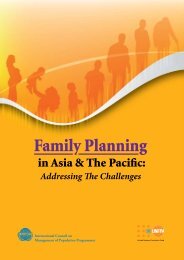Inter-lInkages between PoPulatIon DynamIcs anD DeveloPment In ...
Inter-lInkages between PoPulatIon DynamIcs anD DeveloPment In ...
Inter-lInkages between PoPulatIon DynamIcs anD DeveloPment In ...
You also want an ePaper? Increase the reach of your titles
YUMPU automatically turns print PDFs into web optimized ePapers that Google loves.
PREFACERealising the importance of South-South cooperation and collaboration, ICOMP engaged itself in a shortproject on Capacity Enhancement Utilizing South-South Modalities, which consists of four components,namely: (i) <strong><strong>In</strong>ter</strong>-linkages <strong>between</strong> population dynamics and development in national planning; (ii) Assessingcapacity enhancement needs and database on possible assistance providers for 2010 round of populationcensus; (iii) Assessing institutional capacity for reducing maternal mortality and morbidity; and (iv) Improvingaccess of young people to education and services for sexual and reproductive health, HIV and gender.The objectives of the project were to create a pool of resources for technical assistance, documenting bestpractices and sharing of experiences for enhancing regional capacities using South-South modalities. Thisproject was funded by the Asia and the Pacific Regional Office (APRO), United Nations Population Fund(UNFPA).This publication on <strong><strong>In</strong>ter</strong>-linkages <strong>between</strong> Population Dynamics and Development in National Planning:Case Studies from Bangladesh, <strong>In</strong>dia and Malaysia is a result of the first component: <strong><strong>In</strong>ter</strong>-linkages <strong>between</strong>population dynamics and development in national planning.This publication assessed the incorporation of population dynamics and its inter-linkages with gender equality,sexual and reproductive health in public policies/poverty reduction plan in three selected countries in theSouth and East Asia - Bangladesh, <strong>In</strong>dia and Malaysia. The three case studies were prepared for the purposeof understanding how planning of various key development sectors take into account the population anddevelopment (POPDEV) inter-linkages as well as to identify some promising practices to improve the POPDEVinter-linkages at the country level.<strong>In</strong> addition, the promising practices and challenges identified can be utilised for possible South-Southcollaboration to strengthen national capacity to integrate POPDEV into national and sub-national planningprocesses.We wish to convey our appreciation to the senior/middle level officials - from Bangladesh: the PlanningCommission of Bangladesh, Ministry of Health and Family Welfare, Department of Women’s Affair, and UNFPABangladesh; from <strong>In</strong>dia: the Planning Commission, Government of <strong>In</strong>dia; and from Malaysia: the EconomicPlanning Unit, Prime Minister’s Department of Malaysia - for providing insights into their country nationaldevelopment plans and situation.We wish to express special thanks to the Asia and the Pacific Regional Office of UNFPA for financial supportand guidance.ICOMPKuala LumpurNovember, 2009iv














